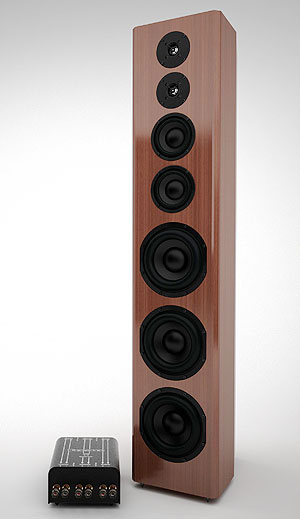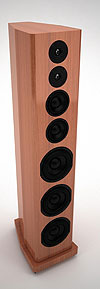| First Impressions: Bryston Model T Basic Loudspeaker |
 When it comes to describing one's impressions within a review-type essay, I think it is easier to exercise criticism than to explain excellence. A reviewer’s obligation is to investigate and describe in detail the performance, character, merit, shortcomings and sonic properties of the component under review. But when being an audio critic turns into listening for pleasure, the critic is in trouble and must re-evaluate his/her position and duty. I found myself in this position dozens of time, but never as blatantly painful as in the past few months — the time I spent listening to the Model Ts and the Tenor Audio amplifier (review pending as I am still working on the Tenor). Nevertheless, here goes ... When it comes to describing one's impressions within a review-type essay, I think it is easier to exercise criticism than to explain excellence. A reviewer’s obligation is to investigate and describe in detail the performance, character, merit, shortcomings and sonic properties of the component under review. But when being an audio critic turns into listening for pleasure, the critic is in trouble and must re-evaluate his/her position and duty. I found myself in this position dozens of time, but never as blatantly painful as in the past few months — the time I spent listening to the Model Ts and the Tenor Audio amplifier (review pending as I am still working on the Tenor). Nevertheless, here goes ...
As the sheer size and number of drivers indicates, the Model Ts do not make polite compromise with the law of physics. However, the size and number of driver is a bit misleading as the Model Ts are very coherent. More about this later, but for now let’s have a look at the design.
The cabinets are solid as the proverbial rock — actually a block of wood, confirmed with the simple knuckle test. In large enclosures this is an important part of the design, here assisted by a non-parallel shape and the sheer weight of 108 pounds each. They stand almost 53 inches high with a footprint of 10.5 (W) by 16.5 (D). The internal cross bracing seems great and keeps resonance to a minimum while the front baffle — a 1.5 inch MDF board — is almost entirely inert. This is where the seven drivers are mounted, two 1-inch tweeters, two 5.5-inch midrange drivers and three 8-inch woofers. The crossover is a unique design that allows a distortion-free divide at 160Hz and 2.3kHz. They are highly efficient at 91 dB (1 watt/meter), but can handle over 500 watts as well as single-ended low-powered tube jobs. The specs state that they can deliver 118 dB —and, as per test, they can authentically reproduce a large orchestra at live volume levels. They do go down to 25 Hz and up to 22 kHz almost flat with small (inaudible) dips here and there. Nominal impedance is 4 ohms. For more Information check the product specs: Model_T_Passive.html
The Model T are available in various finishes at additional cost, though the ones I auditioned were black Ash Vinyl — not the most attractive, The rosewood finish, on the other hand, is very nice indeed ($1000 extra). I realize that audiophiles care little about aesthetics and much about sound and what comes to mind is Henry Ford’s quip that the Model T is available in many colors as long as it’s black.
Other options include external passive or active crossovers (an additional $1000 or $3000) and a full-function active system, the price of which varies depending on the amplifiers used (Bryston amplifiers, of course).
The Listening Tests
I had three amplifiers, two preamplifiers and three sets of cables on hand — each with its own sonic signature and all well known to me. So when I began my auditions, I used the in-house Bryston 7B SST Squared monoblocks with the Modwright preamp and XLO cables. After having listened to this combination for a while, I exchanged the 7Bs with the Aesthetix power amplifier — had that system going for a few days. Next, I inserted the Allnic amplifier and lived with this combination for a few days. Every time I made a change, the Model Ts sound changed as well and that, I feel, is but one of the loudspeakers' meritorious elements. I heard the amps —loud and clear. I changed the speaker cables to the less expensive BIS and Argentum brands and the Model Ts Sonics changed as well and I could clearly hear the connectors' limitations and/or personality.
From a reviewer's perspective, the model Ts are ideal to hear beyond their own sonic disposition as they distinctly reflect whatever is connected to them. From the end-users' position, it allows system configurations to suit whereby one can hear and, hopefully, enjoy the backup amplifiers, preamplifiers, source components as well as the cabling. As one may expect, the three amps I used for the evaluation did imprint their own personality onto the overall sound of the Model Ts. Thus, The 7Bs with their awesome power were solid state, the Aesthetix amp is a 250 watt/channel hybrid and, the Allnic is a fine vacuum tube amplifier — all with the kind of sound that I’d consider to be in the high-end category, though with different voices. My evaluation takes this into account and the following is the description of the loudspeakers’ response shared in these system combinations — and apparent with all.
Here is what got my attention at the very first listening session with the Model Ts: They were as relaxed reproducing a Handel, Beethoven or Mozart as they were doing a small jazz ensemble. They are remarkably linear and realistic in terms of timbre as they handle strings, woodwinds, brass, and the ranges of pipe and Hammond organ; and all with the proper tonal equilibrium and calm. Guitars, drums, electric or full-body bass and, most importantly, voice is on par with the best and most expensive I have come across. Detail — found in the upper mid and high regions — is flawlessly reproduced, something one may expect in live music and without etching or highlighting — very organic in nature.
Imaging is very natural. I venture a guess when I say that the speakers driver arrangement with the two tweeters and two midrange drivers near the top of the enclosure places the treble towards the top, thus slightly elevating the image. The sound stage is most definitely about four feet off the floor.
Bass performance from the Model T is truly outstanding! Lows are concussive, well controlled, very deep and without exaggeration. I noticed that the speaker’s energy at the specified 25Hz was nearly the same at 50 or 60Hz — and that it was clean. Midbass had a lovely bloom and warmth to it, but without the looseness, which so often accompanies that bloom. The deepest bass is sufficiently effortless that one can hear and feel the entire bass spectrum at live listening levels without distortion or colouration. In fact I believe that the speakers surpass or equal the deep bass of a lot of subwoofers I have auditioned in the past. All this, however, without sacrificing detail, control and the ability to reproduce bass notes legitimately.
The Model Ts are dynamic at both low and high levels, Big band jazz sounds like big band jazz. Jimmy Smith's Hammond B3 sounds like the Hammond at the old Colonial Tavern (an old Toronto jazz bar long gone). Beethoven symphonies have full dynamic power, while piano solos — concertos or Brubeck — do not sound nice and polite as with so many other designs, they sound alive, revealing the full power of the concert grand recordings I use for most evaluations — Yamaha, Steinway, Baldwin and Boesendorfer. Shirley Horn sounds — well you get the drift.
 Closing Thoughts and Commentary Closing Thoughts and Commentary
I understand that it took a couple of years to build, test, retest, voice and tweak the Model Ts which, with the cooperation of Axiom, was James Tanner’s project. Tanner’s regular (mundane) job is as marketing VIP for Bryston and, I assume, he took a lot of his spare time to bring his baby to fruition. Time well spent James. The result, the way I see it, is an outstanding design that basically gets out of the way of the music (and its playback electronics) and allows one to listen beyond the equipment. The Model Ts are aptly named as they offer a luxury high-end ride into the world of audio (Model Tanner?). And like the Ford Motor Company’s Model T of times past, they are affordable. I believe that Bryston Model Ts are not priced according to performance, but rather they are priced to sell —and sell they will as sound quality is in line with or better than speakers selling for three times the price and then some. Regular reader will know that my own speakers — the Ethera Vitaes — are used for almost all my evaluations of electronics —and for a good reason: they offer a very high extent of sonic neutrality and transparency. It is this attribute I value as a reviewer and as a listener. I like my sound as organic as possible and am now looking for a long-term loaner from the Bryston folks as the model T matches my Ethera’s sound and adds a thing or two, namely great bass extension and the kind of imaging attainable only with small bookshelf-type enclosures. The speakers mirror the quality of the electronics and will sound good, better or best with a great number of amps. In an addendum (following soon), I will explore how the Model Ts reflect the presence of the Tenor S175 power amplifier that will arrive shortly for a final audition. Keep tuned for the results and possibly a look at the upcoming addition — a stand-mounted smaller version of the Mode T, a Model A?
Finally, I feel obliged to let you know my system preferences. The top rating system combination is the Bryston 7Bs and Aesthetix preamplifier connected with the top-of-the-line XLO cables. All other combinations with the Aesthetix preamplifier sounded a bit more natural to me, while the Modwright preamplifier toned down mids and highs and introduced more of a tube-like sound. The Aesthetix pre and power amplifier combination had a bit of the lovely glow of a tube sound, but the resolution of SS — a very good combination. The Allnic/Modwright combination introduced a lot of warmth, sure to please the tube lovers. The point: The speakers revealed this and in addition clearly showed that cables can make a huge difference.
|
| MODELS |
MANUFACTURER |
| Model T Basic |
Bryston Ltd. |
| RATING |
CONTACT |
| ♪♪♪♪ |
BRYSTON LTD.
677 NEAL DRIVE
PETERBOROUGH, ONTARIO
CANADA
K9J 6X7
PHONE: 705 742-5325
www.bryston.com
|
| PRICE |
| $6,500.00 / pair |
| |
|
|
|
